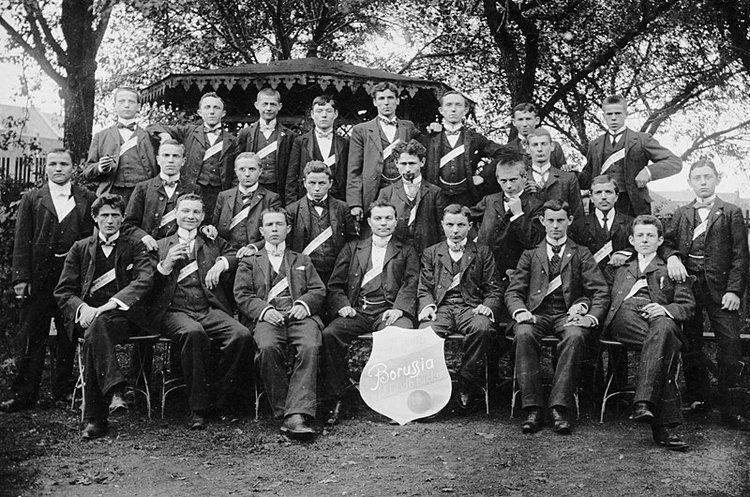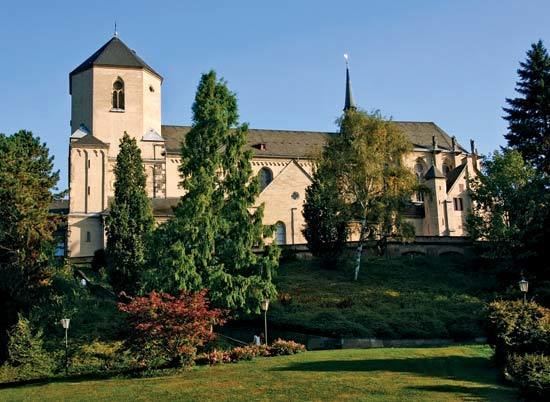Country Area 170.43 km2 | ||
 | ||
Points of interest | ||
District Urban districts of Germany | ||
Mönchengladbach ( [mœnçn̩ˈɡlatbax]), formerly known as München-Gladbach is a city in North Rhine-Westphalia, Germany. It is located west of the Rhine, halfway between Düsseldorf and the Dutch border.
Contents
- Map of Mnchengladbach
- M nchengladbach discover germany
- Name and origins
- Early history
- Recent history
- Points of interest
- Twin cities
- Notable people
- Transport
- Sports
- Military
- References
Map of Mönchengladbach
Mönchengladbach is home of the football club Borussia Mönchengladbach, Formula One race car drivers Nick Heidfeld and Heinz-Harald Frentzen, author/cartoonist Walter Moers, cabaret artist Volker Pispers, philosopher Hans Jonas, Goalkeeper Marc-André ter Stegen and the former football players and managers Günther Netzer and Jupp Heynckes. Joseph Pilates, the creator of the Pilates method of physical fitness, was born here in 1883.
M nchengladbach discover germany
Name and origins

The original name of the city was Gladbach, which is even today often applied to the town. To distinguish the town from another town of the same name (the present Bergisch Gladbach), it took the name München-Gladbach in 1888. This spelling could mislead people to think that Gladbach was a borough of Munich (München in German), and consequently the name was changed to Mönchen-Gladbach in 1950 and Mönchengladbach in 1960.
The origin of the town was an abbey founded in 974. It was named after the Gladbach, a narrow brook, that mostly runs subterraneously today. The abbey and adjoining villages became a town in the 14th century. The town of Rheydt is located nearby and is incorporated into Mönchengladbach today.
Early history
The first settlements in the area of Mönchengladbach are approximately 300,000–400,000 years old and show remains of Homo erectus and Neanderthal. There are numerous cairns from the Neolithic and the Bronze Age.
The history of Mönchengladbach began with the construction of the Gladbach Minster and the founding of an abbey in the year 974 by Gero, Archbishop of Cologne, and his companion, the monk Sandrad of Trier.
To advance the settlement, the monks created a market north of the church in the 12th century. Craftsmen settled near the market. Gladbach received its town charter in 1364–1366. The "town" got a town wall made of stone, which had to be maintained by the citizens. Remains of that wall can be found at the Geroweiher, as can remains of the "Thick Tower", an old fortified tower at the Waldhausener hill. Until the end of the 18th century the city belonged to the department of Grevenbroich within the duchy of Jülich.
On 4 October 1794, the armed forces of the French revolution marched into the town, one day before the fortress Jülich had been handed over. When the Holy Roman Emperor Francis II ceded.the left bank of the river Rhine to France with the Treaty of Lunéville in 1801, Gladbach fell under French laws suppressing religion. This was the end for the abbey, and the monastery was closed. On 31 October 1802, the last 31 monks left the monastery. The contents of the tremendous abbey library, well-known outside of Germany, was scattered or destroyed.
From 1798 until 1814, the Mairie Gladbach was part of Kanton Odenkirchen, Arrondissement Krefeld, of the French Département de la Roer.
Recent history
In 1815, Gladbach became part of the Kingdom of Prussia and seat of the Landkreis Gladbach, which was dissolved in 1929. In 1815 Gladbach became seat of the Bürgermeisterei (Office of mayor), which was split in 1859 into two parts: the City of Gladbach and Office of Mayor Obergeburth. The latter was renamed to München-Gladbach-Land in 1907.
From 1933 through 1975, the neighborhood of Rheydt was an independent city; the split from München-Gladbach was arranged by Joseph Goebbels, who was born locally. After reuniting with Mönchengladbach, the central station (Rheydt Hauptbahnhof) kept its original name, making Mönchengladbach the only city in Germany to have two rail stations each called Hauptbahnhof.
In response to the 10 May 1940 German invasion of Belgium, Mönchengladbach was bombed by British Bomber Command on the evening of 11 May. The bomber crews were attempting to interdict German troop movements on roads, intersections and rail lines in the area, especially the city's railyards. About half of the approximately 36 twin-engine RAF bombers reportedly hit their targets, and three were shot down. Four people were killed on the ground, including a British woman living in Germany.
After the Second World War, in compensation of the occupation of the Netherlands by Germany, several German cities were proposed to be ceded to the Kingdom of the Netherlands. Though never approved, the project would have renamed Mönchengladbach to Monniken-Glabbeek.
Eventually, the Prussian Rhine Province was dissolved after World War II, and the city became part of the new state of North Rhine-Westphalia which was formed in 1946.
Points of interest
Twin cities
Notable people
These people were born in Mönchengladbach, or in Rheydt or Wickrath, formerly independent communities united with Mönchengladbach in 1975.
Transport
The city has two main railway stations: Mönchengladbach Hauptbahnhof and Rheydt Hauptbahnhof, the result of the merger of the two cities, in which the deprecated name for Rheydt Hbf was never removed. Line 8 of the Rhine-Ruhr S-Bahn connects the city to Düsseldorf and Hagen; an extension further westwards is being discussed. A number of regional trains serve Mönchengladbach. By the end of 2009 it was the largest city in Germany without regular long-distance services. With the new schedule for 2010, Mönchengladbach got an InterCity/Intercity-Express connection twice a week.
The city also has a commercial airport called Düsseldorf Mönchengladbach.
Local bus and rail transport is carried out by the NEW-AG under the VRR transport association regulations.
Sports
Mönchengladbach has a long football tradition. Its home club Borussia Mönchengladbach is one of the country's most well-known, best-supported, and successful teams.
Die Fohlen ("The Foals") with more than 50,000 members is rated actually as fourth largest fan-club in Germany. Famous for the attacking style, Gladbach belonged to the strongest European football teams in the 1970s, winning the Bundesliga 5 times. The Club lost the 1977 final of the European Cup to Liverpool, but also made four appearances in the UEFA Cup final with wins in 1975 and 1979 against losses in 1973 and 1980. However, after a last place finish in the top flight for the 2006–2007 season, they were relegated to the 2. Bundesliga (1. and 2. National Leagues) for the 2007–2008 season. They are playing in the Bundesliga again since 2008, surviving relegation in the 2010–2011 season and finishing 4th in the 2011-12 season.
On 30 July 2004 the opening of the new stadium "Borussia-Park" was celebrated. It has a capacity of 54,700 visitors (seated: 34,300, standing: 20,400 / capacity on International games: 45,600). The stadium can be reached by car (through dedicated exit on the Autobahn "A 61"), bus and train.
The city hosted the FIH Hockey World Cup 2006 during the period of September 6–17 and the 2010 FIH Champions Trophy in July/August that year.
Since 1892, Mönchengladbach owns a harness racing track called "Trabrennbahn Mönchengladbach".
Military
Until December 2013, the Rheindahlen Military Complex was located just outside of Mönchengladbach, where it was home to the headquarters of the British Armed Forces in Germany.
